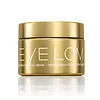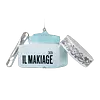What's inside
What's inside
 Key Ingredients
Key Ingredients

 Benefits
Benefits

 Concerns
Concerns

 Ingredients Side-by-side
Ingredients Side-by-side

Water
Skin ConditioningCaprylic/Capric Triglyceride
MaskingPropanediol
SolventC12-15 Alkyl Benzoate
AntimicrobialC12-16 Alcohols
EmollientGlycerin
HumectantDimethicone
EmollientPentylene Glycol
Skin ConditioningSodium Acrylates Crosspolymer-2
AbsorbentGlyceryl Stearate Se
EmulsifyingXylitylglucoside
HumectantBetaine
HumectantPalmitic Acid
EmollientAnhydroxylitol
HumectantHydrogenated Lecithin
EmulsifyingLecithin
Emollient1,2-Hexanediol
Skin ConditioningCrambe Abyssinica Seed Oil
Skin ConditioningHydroxyacetophenone
AntioxidantSodium Hyaluronate
HumectantHelianthus Annuus Seed Oil
EmollientMethylpropanediol
SolventPolyacrylate Crosspolymer-6
Emulsion StabilisingXylitol
HumectantTocopheryl Acetate
AntioxidantAlcohol
AntimicrobialPolysorbate 20
EmulsifyingRetinol
Skin ConditioningCitric Acid
BufferingAvena Sativa Kernel Extract
AbrasiveLactobacillus Ferment
Skin ConditioningDisodium EDTA
Rosmarinus Officinalis Leaf Extract
AntimicrobialRosa Damascena Extract
MaskingTephrosia Purpurea Seed Extract
Skin ConditioningRosa Damascena Flower Oil
MaskingSodium Benzoate
MaskingPotassium Phosphate
BufferingHyaluronic Acid
HumectantSilanetriol
BHT
AntioxidantPotassium Sorbate
PreservativeBHA
AntioxidantTocopherol
AntioxidantAscorbyl Palmitate
AntioxidantCitronellol
PerfumingGeraniol
PerfumingWater, Caprylic/Capric Triglyceride, Propanediol, C12-15 Alkyl Benzoate, C12-16 Alcohols, Glycerin, Dimethicone, Pentylene Glycol, Sodium Acrylates Crosspolymer-2, Glyceryl Stearate Se, Xylitylglucoside, Betaine, Palmitic Acid, Anhydroxylitol, Hydrogenated Lecithin, Lecithin, 1,2-Hexanediol, Crambe Abyssinica Seed Oil, Hydroxyacetophenone, Sodium Hyaluronate, Helianthus Annuus Seed Oil, Methylpropanediol, Polyacrylate Crosspolymer-6, Xylitol, Tocopheryl Acetate, Alcohol, Polysorbate 20, Retinol, Citric Acid, Avena Sativa Kernel Extract, Lactobacillus Ferment, Disodium EDTA, Rosmarinus Officinalis Leaf Extract, Rosa Damascena Extract, Tephrosia Purpurea Seed Extract, Rosa Damascena Flower Oil, Sodium Benzoate, Potassium Phosphate, Hyaluronic Acid, Silanetriol, BHT, Potassium Sorbate, BHA, Tocopherol, Ascorbyl Palmitate, Citronellol, Geraniol
Water
Skin ConditioningGlycerin
HumectantDimethicone
EmollientCyclopentasiloxane
EmollientPropanediol
SolventVinyl Dimethicone/Methicone Silsesquioxane Crosspolymer
Polymethylsilsesquioxane
Dimethicone Crosspolymer
Emulsion StabilisingPEG-9 Polydimethylsiloxyethyl Dimethicone
EmulsifyingSodium Chloride
MaskingXylitylglucoside
HumectantHydroxyacetophenone
AntioxidantAnhydroxylitol
HumectantCaprylyl Glycol
EmollientXylitol
HumectantParfum
MaskingAdenosine
Skin ConditioningGlucose
HumectantDisodium EDTA
1,2-Hexanediol
Skin ConditioningSoluble Collagen
HumectantMagnesium Aluminum Silicate
AbsorbentCI 42090
Cosmetic ColorantPhaseolus Radiatus Seed Extract
Skin ConditioningCaprylic/Capric Triglyceride
MaskingHydrogenated Lecithin
EmulsifyingRetinol
Skin ConditioningPolyglyceryl-10 Myristate
Skin ConditioningTocopheryl Acetate
AntioxidantLinalool
PerfumingWater, Glycerin, Dimethicone, Cyclopentasiloxane, Propanediol, Vinyl Dimethicone/Methicone Silsesquioxane Crosspolymer, Polymethylsilsesquioxane, Dimethicone Crosspolymer, PEG-9 Polydimethylsiloxyethyl Dimethicone, Sodium Chloride, Xylitylglucoside, Hydroxyacetophenone, Anhydroxylitol, Caprylyl Glycol, Xylitol, Parfum, Adenosine, Glucose, Disodium EDTA, 1,2-Hexanediol, Soluble Collagen, Magnesium Aluminum Silicate, CI 42090, Phaseolus Radiatus Seed Extract, Caprylic/Capric Triglyceride, Hydrogenated Lecithin, Retinol, Polyglyceryl-10 Myristate, Tocopheryl Acetate, Linalool
Ingredients Explained
These ingredients are found in both products.
Ingredients higher up in an ingredient list are typically present in a larger amount.
1,2-Hexanediol is a synthetic liquid and another multi-functional powerhouse.
It is a:
- Humectant, drawing moisture into the skin
- Emollient, helping to soften skin
- Solvent, dispersing and stabilizing formulas
- Preservative booster, enhancing the antimicrobial activity of other preservatives
This ingredient is created from dehydrating xylitol in acidic conditions. Xylitol is a famous sugar and humectant.
Much like its predecessor, anhydroxylitol is a humectant. Humectants attract and hold water to moisturize the skin.
This ingredient is most commonly found in a popular trio called Aquaxyl. Aquaxyl is made up of anhydroxylitol (24 - 34%), xylitylglucoside (35 - 50%), and xylitol (5 - 15%).
According to a manufacturer, Aquaxyl is known for a 3-D hydration concept and an anti-dehydration shield to reinforce the outer layer of skin.
This ingredient is often derived from plants such as wood and sugarcane.
Learn more about AnhydroxylitolThis ingredient is an emollient, solvent, and texture enhancer. It is considered a skin-softener by helping the skin prevent moisture loss.
It helps thicken a product's formula and makes it easier to spread by dissolving clumping compounds.
Caprylic Triglyceride is made by combining glycerin with coconut oil, forming a clear liquid.
While there is an assumption Caprylic Triglyceride can clog pores due to it being derived from coconut oil, there is no research supporting this.
Learn more about Caprylic/Capric TriglycerideDimethicone is a type of synthetic silicone created from natural materials such as quartz.
What it does:
Dimethicone comes in different viscosities:
Depending on the viscosity, dimethicone has different properties.
Ingredients lists don't always show which type is used, so we recommend reaching out to the brand if you have questions about the viscosity.
This ingredient is unlikely to cause irritation because it does not get absorbed into skin. However, people with silicone allergies should be careful about using this ingredient.
Note: Dimethicone may contribute to pilling. This is because it is not oil or water soluble, so pilling may occur when layered with products. When mixed with heavy oils in a formula, the outcome is also quite greasy.
Learn more about DimethiconeDisodium EDTA plays a role in making products more stable by aiding other preservatives.
It is a chelating agent, meaning it neutralizes metal ions that may be found in a product.
Disodium EDTA is a salt of edetic acid and is found to be safe in cosmetic ingredients.
Learn more about Disodium EDTAGlycerin is already naturally found in your skin. It helps moisturize and protect your skin.
A study from 2016 found glycerin to be more effective as a humectant than AHAs and hyaluronic acid.
As a humectant, it helps the skin stay hydrated by pulling moisture to your skin. The low molecular weight of glycerin allows it to pull moisture into the deeper layers of your skin.
Hydrated skin improves your skin barrier; Your skin barrier helps protect against irritants and bacteria.
Glycerin has also been found to have antimicrobial and antiviral properties. Due to these properties, glycerin is often used in wound and burn treatments.
In cosmetics, glycerin is usually derived from plants such as soybean or palm. However, it can also be sourced from animals, such as tallow or animal fat.
This ingredient is organic, colorless, odorless, and non-toxic.
Glycerin is the name for this ingredient in American English. British English uses Glycerol/Glycerine.
Learn more about GlycerinHydrogenated Lecithin is created from the hydrogenation of lecithin (a group of phospholipids). Hydrogenation is a chemical reaction between hydrogen and another element.
This ingredient is an emollient and emulsifier. As an emollient, it helps soften skin by trapping moisture within. As an emulsifier, it prevents oil and water ingredients from separating.
Hydroxyacetophenone is antioxidant with skin conditioning and soothing properties. It also boosts the efficiency of preservatives.
This ingredient is not irritating or sensitizing.
Propanediol is an all-star ingredient. It softens, hydrates, and smooths the skin.
It’s often used to:
Propanediol is not likely to cause sensitivity and considered safe to use. It is derived from corn or petroleum with a clear color and no scent.
Learn more about PropanediolRetinol is a gold-standard ingredient for anti-aging. It is a form of Vitamin A and belongs to the class of retinoids that also includes tretinoin.
Why is retinol famous?
It has the most scientific studies backing up its skin benefits out of all the non-prescription ingredients.
Retinol is proven to:
This is why retinol is effective at removing wrinkles, fading dark spots, treating acne, and reducing the appearance of pores.
Studies show retinol is less effective when exposed to UV. Be sure to look for appropriate packaging to keep your retinol potent (similar to Vitamin C).
Using retinol or any retinoids will increase sun-sensitivity in the first few months. Though studies show retinoids increase your skin's natural SPF with continuous use, it is best to always wear sunscreen and sun-protection.
We recommend speaking with a medical professional about using this ingredient during pregnancy.
Retinol may cause irritation in some people, so be sure to patch test. Experts recommend 'ramping up' retinol use: start using this ingredient once a week and work up to using it daily.
Read about Tretinoin
Learn more about RetinolTocopheryl Acetate is AKA Vitamin E. It is an antioxidant and protects your skin from free radicals. Free radicals damage the skin by breaking down collagen.
One study found using Tocopheryl Acetate with Vitamin C decreased the number of sunburned cells.
Tocopheryl Acetate is commonly found in both skincare and dietary supplements.
Learn more about Tocopheryl AcetateWater. It's the most common cosmetic ingredient of all. You'll usually see it at the top of ingredient lists, meaning that it makes up the largest part of the product.
So why is it so popular? Water most often acts as a solvent - this means that it helps dissolve other ingredients into the formulation.
You'll also recognize water as that liquid we all need to stay alive. If you see this, drink a glass of water. Stay hydrated!
Learn more about WaterXylitol is a humectant and prebiotic. It can help with dry skin.
In studies, xylitol has been shown to improve dry skin. It decreased transepidermal water loss, or when water passes through the skin and evaporates. Xylitol also showed to help improve the biomechanical properties of the skin barrier.
The prebiotic property of xylitol may also help reinforce our skin's natural microbiome. Having a healthy microbiome prevents infection by bad bacteria and helps with hydration.
As a humectant, Xylitol helps draw moisture from both the air and from deeper skin layers. This helps keep skin hydrated.
Xylitol is a sugar alcohol and commonly used as a sugar substitute. It is naturally occurring in plants such as strawberries and pumpkin.
Learn more about XylitolXylitylglucoside is created from xylitol and glucose, two humectants.
Not surprisingly, this ingredient is also a humectant. It attracts and holds water in your skin, helping to maintain hydration.
This ingredient is most commonly found in a popular trio called Aquaxyl. Aquaxyl is made up of anhydroxylitol(24 - 34%), xylitylglucoside (35 - 50%), and xylitol (5 - 15%).
According to a manufacturer, Aquaxyl is known for a 3-D hydration concept and an anti-dehydration shield to reinforce the outer layer of skin.
Learn more about Xylitylglucoside